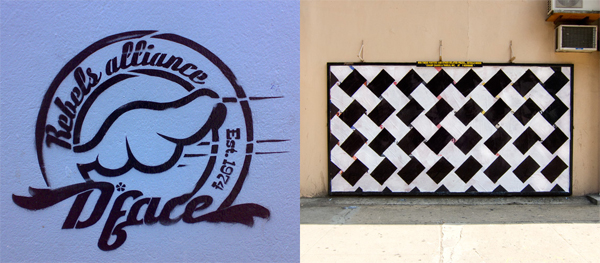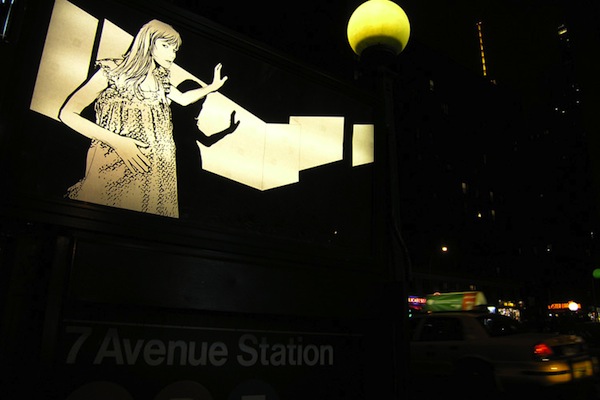
I want to look at two very different artists and how they tackle advertising and the media in their art: D*face and Jordan Seiler.
D*face is known for billboard takeovers, messing with pop culture icons, messing with corporate logos and his “d-dog” icon. He’s kind of like Kaws in that D*face inserts himself into pop culture, but D*face’s work is typically subversive or critical of advertising, marketing and things like that. On the other hand, KAWS is inserting himself into pop culture in order to embrace it and become a part of it. Actually, D*face probably explains his art better himself in a new video for Don’t Panic:
I think it’s fair to say that D*face is “against” advertising, or at the very least that his critique of it doesn’t paint a pretty picture. I would also say that D*face has been, throughout his career, very good at subverting advertising, media and pop culture. Yet, there’s something about D*faces work that doesn’t subvert advertising at all. In fact, in some ways, D*face’s art embraces advertising. Like Shepard Fairey (one of D*face’s major influences), D*face has an “icon” or a “logo” of his own. The d*dog or elements of the d*dog appear throughout his work, as does D*face’s own name. So is D*face advertising himself by subverting advertising? Certainly. Is that his intent? I’m not sure. And if it is, it’s worth mentioning the standard argument defending that: (except for Shepard Fairey who has teams of wheatpasters) an individual artist doesn’t have the resources to advertise themselves on anywhere near the scale that a brand like Coke can advertise and the artist is putting up art while advertisers are solely trying to sell a product. Additionally, D*face’s use of a logo has probably helped him to become the success he is today, which in turn allows him to do crazy projects like this and increase awareness for his agenda of getting people to question advertising and mass media.
For those familiar with Adbusters, this paradox might be familiar. The Adbusters organization sells shoes which are essentially made in opposition to Converse and branded shoes made in sweatshops, but by creating an anti-brand, they have created their own shoe brand.
Jordan Seiler, like D*face, is known for billboard takeovers but also for his efforts to change/eliminate advertising in the public space. In addition to his own art, Jordan organized NYSAT and TOSAT. Throughout his outdoor art career, Jordan’s style has changed more drastically than the average street artist. While there are a few reoccurring motifs (like a use of simple geometric patterns and shapes), each project is very distinct and it would be hard for me to define a specific style for Jordan (unless doing ad takeovers is itself a style). Additionally, I don’t think I’ve ever seen Jordan sign his outdoor work. Recently, Jordan has been preparing to retire one of the designs that he has used for a while now and is starting to become identified by, his Weave It design.

On his blog, Jordan recently explained that he was finishing up the Weave It project (as he had ended projects previously before they became “iconic”) “in order to remained un-branded as an artist and therefor escape criticism that I use the streets and advertising venues as advertising for myself.” Two days later, Jordan restated his feelings in another post. Once again, Jordan said that he is moving on from the design in an effort to “prevent branding of PublicAdCampaign imagery.”
To most street artists, changing their style regularly and actively trying to avoid any identifiable trademarks might seem like a novel and counter-intuitive idea, but Jordan seems to be sacrificing potential short-term artist notoriety for his long-term political aims. The flip-side of this strategy is that a lot of Jordan’s art isn’t immediately obvious as an advertising takeover. Most of the takeovers don’t scream out “I am here instead of an advertisement,” so the art can easily be ignored or even possibly confused as some sort of guerrilla marketing campaign. While D*face’s artwork makes itself obvious and forces people to re-examine the world we live in, perhaps Jordan’s more subtle techniques cause the art and the action he has taken to be overlooked (although, and I’m not sure about this, he might argue that that’s sort of the point in some cases).
I emailed briefly with Jordan and he clarified his position on using logos in art. Surprisingly, he said “My thoughts on logo reproduction in street art and ad takeovers are not as idealistic as that which I practice” and he actually doesn’t believe that street artists shouldn’t use logos, just that “I choose to go as far as I can from logo production and stylistic similarities (which I can often fail at) mostly because I choose only to hit ads and therefore am under even higher scrutiny when being asked if my work is self promotional.”
–
So whose work to you think is more effective? Let me know in the comments.
Photos by hebedesign and Jordan Seiler
